Where the Eagles fly
By Hillel
Figuring out your next photography quest is like picking a good restaurant. You don’t want to eat at the same joint frequently because you will likely find it boring over time. You don’t want to pick a restaurant randomly because the odds of the place having food you like, a comfortable setting, and reasonable prices is low and ultimately risky. Recommendations from friends are a good start, but even then, tastes vary. Critiques can’t be relied on either. A friend may rave about a place, and you might then decide on a whim to go and try it out. After your little experiment, you’re left wondering if you came to the wrong place, the friend was simply distracted by a waitress, or they were paid handsomely for their recommendation.
The same concerns can be said for photography trips. I live in Maryland, and there are only several obvious opportunities nearby. DC is the most obvious choice. But, the monuments have been there for centuries and photographed from nearly every angle by now. The Cherry Blossom festival is worth it, but that’s only for one week a year, and you will only be one of millions in attendance. It’s hard to get a unique shot with hundreds of other people walking around in the background – all taking pictures too. The fourth of July festival is even shorter lived with even greater crowds. Parades, races, and mall events are fun but they are crowded and rarely provide unique or entertaining shots. Dr. Seuss would say: “You can shoot DC at night, in the rain, through the snow, or during an eclipse. You can shoot DC in 3D, as a panorama, or in HDR. But you will NOT be the first nor last to do so!”.

Ok. So, maybe DC is out. What about the National Zoo, only a few blocks from the metro? Well now, the zoo is a good opportunity to get unique shots of animals. But, they are not living as they would in the wild, and it’s unlikely that you will catch two zebra’s fighting or a leopard tackling prey. It is likely that you will shoot through glass. It is likely that you will capture walls, doors, fences, buckets, and other unnatural objects in the bokeh of your shots. And, finally, it is likely that you will be trudging up and down the big hill where the zoo is located. But the attraction is free, and it’s open consistently, so I encourage you to give this venue a try if you haven’t tried it yet.
Th area around DC does provide many places to photograph plants and insects. I have been to the Meadowlark Botanical Gardens in Vienna Virginia, the Brookside Gardens in Wheaton Maryland, and the Hillwood Gardens in DC. All are fun to visit once or twice, but these venues are seasonal, most cost money, and you will probably need to by a macro lens to make these trips worth it. Still, these photo stops are options during the warmer months.
There are many day trips you can take to nearby parks and lakes. You can even hop on over to Assateague Island and the Chincoteague National Wildlife Refuge. These are good areas to capture wild horses in large fields, nearly empty beaches, interesting sunset panoramas, and the occasional bird. But except for the horses, the animals are generally skittish because they aren’t used to visitors. Also, most of the scenery is low and uninteresting. This isn’t the Rockies or the Blue Ridge mountains you know. This isn’t even the vast New Jersey wetlands. This is just typical eastern shore dunes, grasses, and shrubs with a coastal tree thrown in for good measure. Not exactly National Geographic material.

So, where can you go within two hours of the DC metro area if you want to get extraordinary shots? Compounding the problem, let’s say it’s nearly Winter – make it early December. This was exactly the problem posed to me by my good friend and great photographer, Tom Schwab. Both of us were available for an all-day Saturday shoot in the coming weekend. Tom suggested a 2,188 acre State Park called Elk Neck which was nearby, and known as a good hawk and eagle hangout during the migratory season. I didn’t offer a better alternative, and he was my x-boss, so how could I say no? I was also anxious to try out my new versatile Nikon 28-300mm lens which I had purchased only a few weeks prior. Placed on my D300, that would produce an equivalent focal length of over 400mm.
Early Saturday morning, around 7:30, Tom pulled up to my house and I loaded my gear which included an iPhone charger, several Zegat bars, and quite a few hand warmers. As we pull away, Tom informed me that we could make it to Elk Neck, but we should start at a Dam not far away from the park first. Now I know Tom, and he definitely does his research. Still, I’m trying to put two and two together. I’m not coming up with four. I asked him why there. Tom replied that many of the photo tours hang out there. At this point, I’ve got an image in my head of a bunch of freezing photographers standing up on top of a Dam and looking down at the white froth below. But, none of the photographers look happy in this picture, except for their well-paid leader. So I asked more questions.
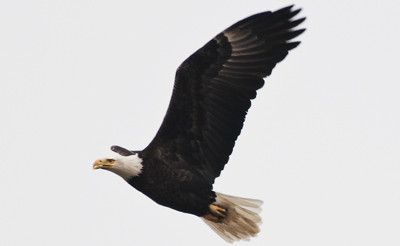
Eventually Tom divulged that fish are forced through the dam outlets and get churned up in the process. And, whether they are stunned or near death, they are easy pickings for birds who aren’t afraid to reach into the frigid Susquehanna River. His story began to make sense, as I looked up the dam’s location in Google maps. Indeed, the dam is not far from the park, and also not to distant from Havre De Grace. On our way to our family’s bi-yearly visit to Livingston, New Jersey for Thanksgiving, we always pass over the interstate 95 bridge near Havre De Grace. This bridge marks the halfway point on our long holiday pilgrimage, and a sense of relief usually overcomes me as we reach it, having left both the congested Washington and Baltimore areas behind.
It takes over an hour and half to get to the dam area from Rockville, so we spent much of our time to catching up on our recent photographic journeys. I’m more of a hobbyist, while Tom has crossed over into the real world of photography by actually printing, matting, framing, and selling his paintings at a variety of trade shows and online. Tom is very methodical and content to master each aspect of photography systematically – taking courses at the Smithsonian, researching options, buying specialized equipment, and tinkering with settings and techniques ad nausea.
I, on the other hand, move quickly from one aspect of photography to another, usually playing with a single technique long enough to get a good sense of what is entailed, but not necessarily long enough to become an expert in it. For example, I have worked hard to understand and produce 3D anaglyph stills, wiggle GIFs, stitched panoramas, and HDR composites. I have photographed various Boy Scout events, talent shows, plays, Bat-Mitzvahs, and even my sister’s wedding. I have printed many of my pictures on one of two large format Epson printers I own, and I have even produced a professional coffee table wedding album. Many of my pictures have made it into the yearly FDA publications, though I did not even win an honorable mention for my submission to the Washington Post’s Travel Photography competition this year. A few of my pictures make it to Facebook, and some can be seen framed at my wife’s office. Basically, when it comes to photography, I’m a jack of all trades, master of none.
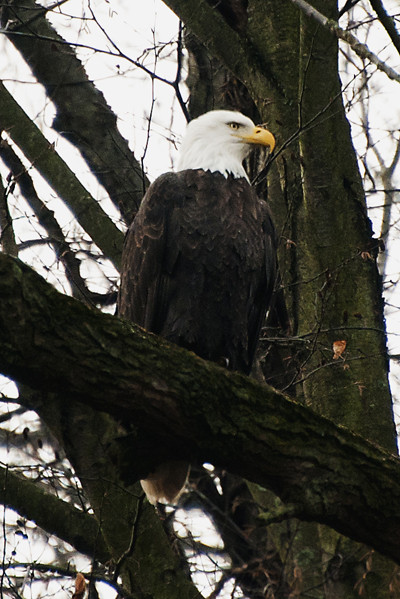
Truth be told, though, these unique areas of photography overlap considerably. That is, whether you’re producing an HDR composite or a stitched panorama, you need to be intimately aware of end work’s composition, lighting, depth-of-field, and timing. The principles of choosing the right combination of aperture, speed, and ISO are immutable. Creativity does come into play, but there are only so many combinations which produce flattering results. Thus, as I’ve moved through different aspects of photography, my core skill set is continually improved. Not only do I quickly recognize what to do in various situations now, I am far better at “developing” the raw image after the shoot than I was… when I *thought* I was good. Now I often find myself processing the picture in my mind even before I take the shot. I often alter the exposure or increase the framed area in advance of taking the shot knowing that I will have to compensate for the exposure and recrop the image later.
As we approached the dam, I guided Tom in using Google Maps on my iPhone. I switched to satellite mode to figure out what it would look like as we arrived. I was trying to figure out where we could eventually expect to park. As far as I could tell, there appeared to be parking on the right of the dam entrance, but nothing on the dam itself, nor an opportunity after it. When we finally reach the dam, I was ready to tell Tom to pull over, but there was absolutely no place to do so. The top of the dam was essentially a tight narrow bridge. We continued to the other side with plenty of traffic following right behind us. The other side appeared not to offer parking as expected. Finally, we pull over at the next turnoff and considered our options. Tom apparently hadn’t gotten this far in his research.
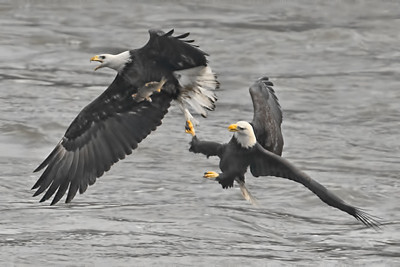
After reviewing the satellite imagery one more time, I could see what went wrong. Indeed, there was a parking lot on the source side, only it lay hundreds of feet below. There was no way to get directly from the top down. Instead, there appeared to be a road just prior to the dam which offered a switchback to approach the waters edge… and what looked like a parking lot. We turned around, and returned to the other side of the dam.
We quickly found the turnoff and headed down towards the Susquehanna river. When we arrived, we entered through an empty toll. I guessed that entering this parking area would cost money on a normal weekday. The long parking lot seemed to extend all the way from the lot’s entrance to the dam itself, following the river’s edge. Within seconds, though, we knew we had arrived at the right place. A man, for example, was standing in the middle of the long parking lot taking pictures of something unknown with rather expensive gear. The lens on his camera was essentially endless. We decided it would be easier to just park and scope out the area on foot, and this is exactly what we did.
Ultimately, we should have parked much closer to the dam, because the lot was much longer than we had imagined it. But, there were clusters of photographers hanging out at several places along the parking lot which offered a wooden fence, and even a balcony to walk out for better viewing. Some of the more courageous photographers had already scrambled down to the rivers edge to get the best view. From just about anywhere along the bank, though, you could see the dam, the Susquehanna, and a large island in the middle of the river with several power-line towers on it.
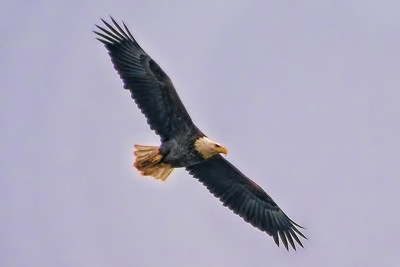
Within a few minutes of breaking out our equipment, however, an alarm sounded, and red lights began to flash along the length of the island in the middle of the river. When we asked folks around what was up, we were informed that the dam was going to release more water soon. At this point Tom noted that the previous river’s level could be clearly seen by the discoloration of the rocks along the far island’s bank. It was also becoming apparent why these photographers were situated here. Adjacent to the dam there were huge shallow areas with plenty of boulders poking up. Thousands of small birds circled these shallow areas searching for their next entree. On the island before us, several towers stood hosts to much larger birds. I took off my lens cap and tried out the new Nikon lens at it’s highest magnification. These were indeed Bald Eagles, and there were many of them. Tom and I looked at each other with the widest grins.
We found a good place by the bank of the river closer to the dam than most. Our lenses were good, but 300mm and 400mm focal length lenses weren’t going to do much with subjects on an island sitting in the middle of a river. Most of the folks around us had lenses with focal lengths far greater than 500mm. Tom attempted to ask one of the photographers nearby if their lens was a 500mm, and received an irritated grunt in response. “It’s an 800mm lens… with manual focus…” We waited now with reserved anticipation.
Not long after we setup or gear, a shout arose: “Two adults and a juvie on the right!”. All the expensive glass in the parking lot swiveled to the right in unison. Apparently, some eagles had left the tower after spotting a potential meal. They came down low on the river and the eagle in front grabbed something out of the frigid water. A fight quickly ensued as a second eagle tried to grab the catch from the first. Pretty soon, all three eagles were gone, and the chatter in the parking lot swelled. Apparently an adult spotted the catch. A young eagle (called a juvenile or “juvie”) decided to follow for instruction. A third eagle decided to wait for the catch before making a timely ambush.
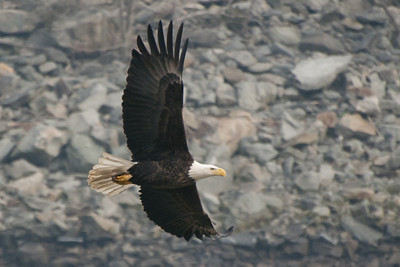
Soon, the conversation died down, and we waited several minutes more. Similar events soon repeated again and again with different configurations and outcomes. Because the birds were gliding over the river directly in front of us, our lenses were finally matched for many of these shots. The trick was to follow the action from well before the culmination of events. We eventually fine-tuned our speeds and exposures during the next few repetitions. I eventually switched in my fast compact flash card because the slow one was not keeping up with the action. I also switched to my D300 body from the D700 to get the extra crop factor (1.5x more zoom).
On one of the passes which followed, the lead eagle could not acquire its target, and instead of heading back to the power-line towers, it circled around and settled on a tree directly behind us. I spun around and snapped off quite a few hand-held shots without moving. After a while, though, I realized that the eagle wasn’t going anywhere. My guess was it wanted to chill until another suitable meal came along. I quickly moved Tom’s tripod up the hill, closer to the bird. I then set out back to the car to get my tripod which I had not really thought suitable until now. It was then that I realized just how inconveniently far we parked from where we were camping. It was too late to change things now. I ran back to the car, grabbed my tripod (and some hand warmers), and returned to our spot. The eagle still had not moved, and was patiently waiting for a decent meal, and occasionally observing us with curiosity. I quickly set up the tripod, and was able to take quite a few triggered shots of the bird before he finally found his mark.
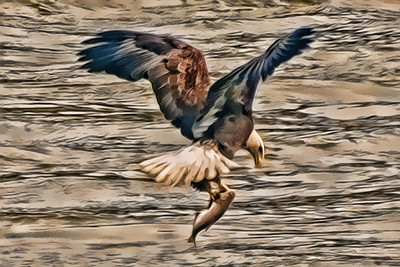
For the next hour, we settled into the pattern, and had a lot of fun tracking the birds, and listening to the photographers’ chatter. Apparently, this year was a good one for Bald Eagles. It seems that these birds have made quite a comeback from their near extinction. After a while, however, we began to get hungry. Tom suggested that we eat on the way to our original destination. We packed up our gear, quite satisfied, and headed back towards Elk Neck State Park along the opposite side of the Susquehanna river. After a few short detours, we found suitable dining in an authentic pizza joint just outside the park.
It was getting late has we entered Elk Neck, and we knew this would be it for the day. I had high hopes for the park, but no matter what, with the earlier visit to the dam, this day would not be considered a loss. We found a parking spot as well as a trail leading deeper into the park. We took out our packs and headed up the path. We were soon led to a covered kiosk with various bulletins posted on it. One of the postings announced proudly that the previous years had produced new record highs for eagle and hawk sightings. Hundreds of large birds were apparently spotted in the park in the past, but curiously enough… no large birds… or people could be found that evening. We were starting to sense that this may not have been the best idea. There might be many migratory birds stopping in the park on their way south, but the lack of visitors would surely make them skittish if they were nearby.

It was getting late, and just as we were loosing hope, the path ended abruptly at a lighthouse. The short structure was well placed on the top of a high plateau overlooking the Chesapeake. There were no large birds around, but the sun was dipping low against the winter sky. We took a variety of shots of the lighthouse, the cliffs, the water below, and the pretty sunset. Before going, we hiked down a short path to the water’s edge to get a closer look. Again, no wildlife could be found, but the rocky shore was picturesque, and I shot a few more rounds and panoramas before returning back to the top. The sign on the lighthouse said that it would not reopen to visitors till April. We weren’t going to wait till April, so we returned quickly along the path back to the car. By sundown the temperatures dropped, and we were glad to get going.
On the way back, Tom and I talked about our success at the dam, and our near failure at the national park. We discussed coming back to the river for another go at the Bald Eagles, seeing as how cooperative they were. Eventually our conversations drifted and we discussed our families and future plans. Subconsciously, though, we were both anxious to look over the pictures we had just taken. I have been on many photo shoots, and it is hard to determine your success until the pictures are evaluated in detail. Using the picture’s EXIF data, its easy to see which settings worked, and which settings did not. The results are sometimes rather surprising. The lessons-learned from this trip will impact our future compositional techniques as well as our next choice of venue. At the end of the evening, as Tom dropped me off, I was only sure of two things. One, that one day I would return to the Dam to visit the migrating Bald Eagles. And two, that I would bring a lot more hand-warmers this time!

[whohit]-EAGLESFLY-[/whohit]

Post a Comment
You must be logged in to post a comment.